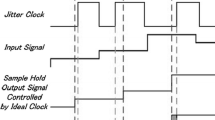Abstract
Phase rotator-based digital clock and data recovery (CDR) using multi-level bang-bang phase detector (ML-BBPD) and time to digital converter (TDC) is analyzed at system and circuit level. A model is proposed for calculating the quantization noise and bit error rate (BER), in order to evaluate the important parameters in CDR design. The jitter analysis is done based on the probability density function achieved from the quantization noise error of the BBPD and TDC. The analysis of ML-BBPD is shown that by increasing the number of sampling clocks, the quantization noise and consequently the jitter and BER are significantly reduced. Also, it is shown that by improving the resolution of the TDC and increasing number of delay cells for the purpose of keeping fixed the dynamic range, the output jitter of TDC is decreased. In the proposed model and also simulation, it is approved that by increasing the ratio of RMS input Gaussian jitter to the quantization step, the output jitter reaches to its saturated value. To prove the jitter model, the goodness of fit test based on Kolmogorov–Smirnov test is used and in addition, the simulation is provided for circuit level CDR. The circuit level simulation is done in TSMC 65 nm CMOS technology. The CDR is worked under 1 V supply voltage at 480Mbit/s bit rate useful for USB2 applications. The CDR dissipates 913 µW power and generates 0.258 ps RMS jitter, while it occupies 166 µm × 104 µm chip area.















Similar content being viewed by others
References
H. Adrang, H. Miar-Naimi, Modeling of jitter in bang-bang CDR with Fourier series analysis. IEEE Trans. Circuits Syst. I Regul. Pap. 60, 3–10 (2013). https://doi.org/10.1109/TCSI.2012.2215787
H. Adrang, H. Miar-Naimi, Nonlinear analysis of BBCDR jitter generation using Volterra series. IEEE Trans. Circuits Syst. II Express Briefs 60, 197–201 (2013). https://doi.org/10.1109/TCSII.2013.2251947
R.E. Best, All-Digital PLLs in Phase Locked Loops: Design, Simulation, and Applications (Oberwil, Switzerland, 2007).
P. Bromiley, Products and convolutions of Gaussian probability density functions. Tina-Vision Memo 3, 1–13 (2018)
G.P.E.V. Bueren, Clock and data recovery circuit and clock synthesizers for 40 Gb/s high-density serial I/O-links in 90-nm CMOS. Ph.D. dissertation, Dept. Elect. Eng., ETH Zurich Univ., Zürich, Switzerland (2011)
Z. Cheng, X. Zheng, M.J. Deen, H. Peng, Recent developments and design challenges of high-performance ring oscillator CMOS time-to-digital converters. IEEE Trans. Electron Devices 63(235), 251 (2016). https://doi.org/10.1109/TED.2015.2503718
K. Ch Hsu, A 1.25~6 Gbps burst-mode clock and data recovery circuit. Master dissertation, Dept. Elect. Eng., National Chiao Tung Univ., Hsin-Chu, Taiwan (2007)
N. Da Dalt, Markov chains-based derivation of the phase detector gain in bang-bang PLLs. IEEE Trans. Circuits Syst. II Express Briefs 53, 1195–1199 (2006). https://doi.org/10.1109/TCSII.2006.883197
Q. Du, J. Zhuang, T. Kwasniewski, A low-power, fast acquisition, data recovery circuit with digital threshold decision for SFI-5 application. IEEE Trans. Very Large Scale Integr. VLSI Syst. 17, 1742–1748 (2009). https://doi.org/10.1109/TVLSI.2009.2017794
M. Gholami, Y. Baleghi, G. Ardeshir, Design of novel testable and diagnosable phase-frequency detector. Circuits Syst. Signal Process. 33(999), 1018 (2014). https://doi.org/10.1007/s00034-013-9679-z
A. Gothandaraman, Design and implementation of an all digital phase locked loop using a pulse output direct digital frequency synthesizer. Master of Science dissertation, Dept. Elect. Eng., The University of Tennessee, Knoxville (2004)
A. Khalil, K. Ibrahim, A. Salama, Design of ADPLL for good phase and frequency tracking performance. In Proceedings of the Nineteenth National Radio Science Conference (2002), pp. 284–290. https://doi.org/10.1109/NRSC.2002.1022634
J. Lee, K.S. Kundert, B. Razavi, Analysis and modeling of bang-bang clock and data recovery circuits. IEEE J. Solid-State Circuits 39, 1571–1580 (2004). https://doi.org/10.1109/JSSC.2004.831600
A. Papoulis, Probability & statistics. USA (1990)
M.I. Ribeiro, Gaussian Probability Density Functions: Properties and Error, Characterization (Institute for Systems and Robotics, Lisboa, 2004).
S. Salem, M. Saneei, All-digital clock and data recovery circuit for USB applications in 65 nm CMOS technology. AEU-Int. J. Electron. Commun. 103, 1–12 (2019). https://doi.org/10.1016/j.aeue.2019.02.020
C. Sanchez-Azqueta, C. Gimeno, C. Aldea, S. Celma, New multilevel bang-bang phase detector. IEEE Trans. Instrum. Meas. 62, 3384–3386 (2013). https://doi.org/10.1109/TIM.2013.2273611
S. Sofimowloodi, F. Razaghian, M. Gholami, Low-power high-frequency phase frequency detector for minimal blind-zone phase-locked loops. Circuits Syst. Signal Process. 38(498), 511 (2019). https://doi.org/10.1007/s00034-018-0887-4
A. Sripad, D. Snyder, A necessary and sufficient condition for quantization errors to be uniform and white. IEEE Trans. Acoust. Speech Signal Process. 25, 442–448 (1977). https://doi.org/10.1109/TASSP.1977.1162977
C.C. Wang, Z.Y. Hou, C.L. Chen, D. Shmilovitz, A lock detector loop for low-power PLL-based clock and data recovery circuits. Circuits Syst. Signal Process. 37(1692), 1703 (2018). https://doi.org/10.1007/s00034-017-0621-7
M. Zanuso, D. Tasca, S. Levantino, A. Donadel, C. Samori, A.L. Lacaita, Noise analysis and minimization in bang-bang digital PLLs. IEEE Trans. Circuits Syst. II Express Briefs 56, 835–839 (2009). https://doi.org/10.1109/TCSII.2009.2032470
Funding
This research did not receive any specific grant from funding agencies in the public, commercial or not-for-profit sectors.
Author information
Authors and Affiliations
Corresponding author
Ethics declarations
Conflict of interest
The authors declare that they have no conflict of interest.
Additional information
Publisher's Note
Springer Nature remains neutral with regard to jurisdictional claims in published maps and institutional affiliations.
Rights and permissions
About this article
Cite this article
Salem, S., Saneei, M. & Abbasi-Moghadam, D. Jitter Modeling in Digital CDR with Quantization Noise Analysis. Circuits Syst Signal Process 40, 3884–3906 (2021). https://doi.org/10.1007/s00034-021-01653-5
Received:
Revised:
Accepted:
Published:
Issue Date:
DOI: https://doi.org/10.1007/s00034-021-01653-5




